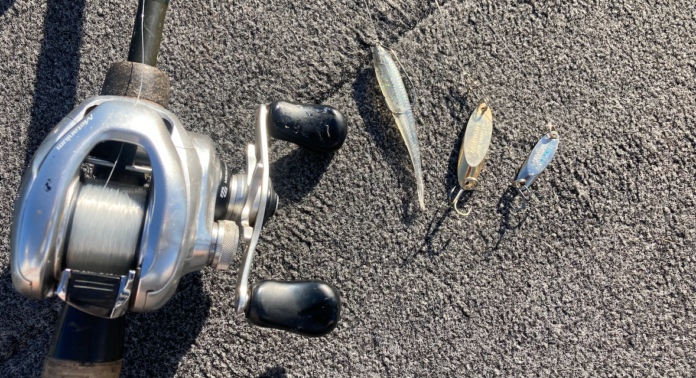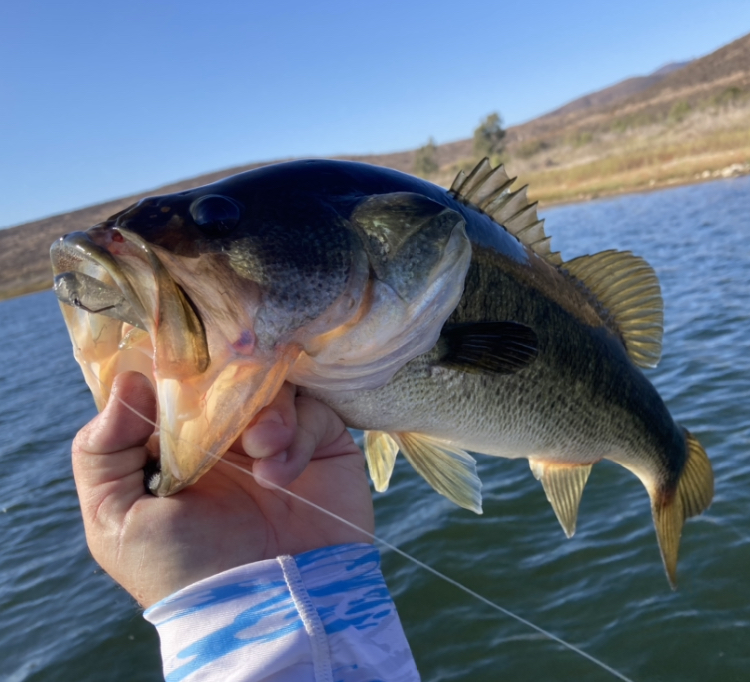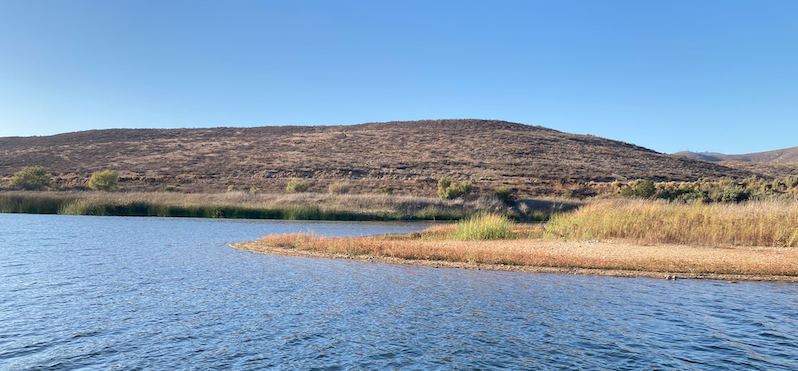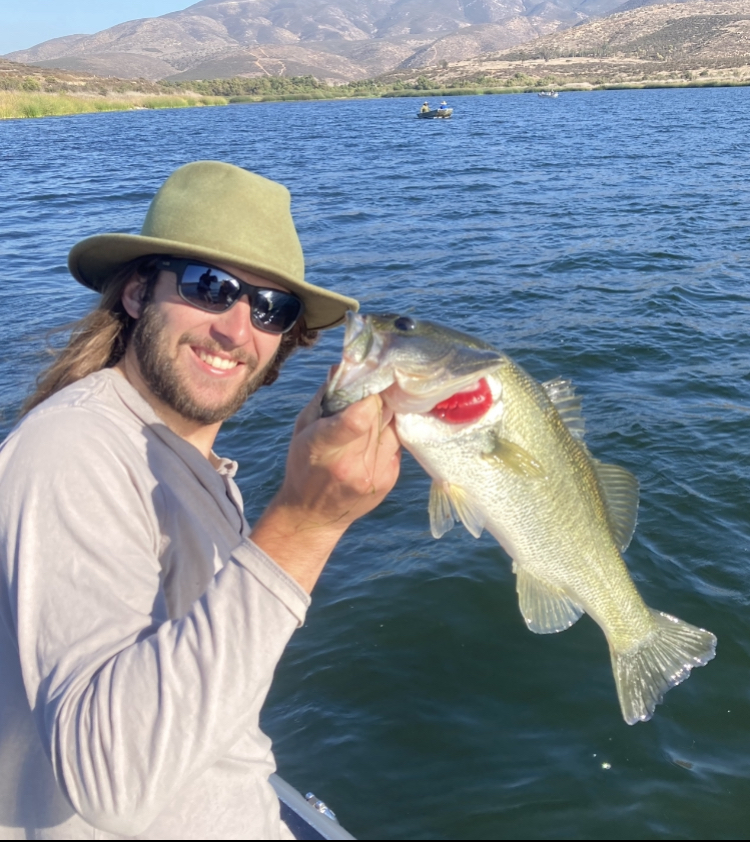
BY ROB MAGARGAL
Yes, it is Southern California, the land of sunshine year-round. But we still have a fall bass fishing pattern just like anywhere else. Every location has their seasonal changes — some are just more extreme than others.
Our fish have been conditioned like other areas and know when the seasonal changes are taking place. Our water temp drops from the high 80s to low 70s vs. high 70s to the low 60s or even the higher 50s range.
In the end, the fish respond the same. In the fall, the fish school up and they start moving with a pack mentality allover the lake. They’re in hot pursuit of baitfish.
Their job now is to get as much food as they possibly can with winter fast approaching. While the water is still warm and their metabolism is high enough, the baitfish can get easily corralled. It’s an all-you-can-eat buffet for the fish from late September through November in SoCal.
However, as great as that sounds, it’s just not that easy. You still have to find the active schools. You still have to present the correct bait choices. You could be tossing all the right baits in all the wrong spot on your home water, and/or tossing the wrong baits in all the right spot on your home water. Both equal a bad day on the lake.
The key here is not to get locked into a single bait that has worked in the past or one location that has produced well at one point. The fish and the bait are moving and it can be different from day to day, and even minute to minute.
I say this to my fishing partners all time when I feel we need to make a change. Let’s take a drive. Meaning essentially that we need to look around a bit to see what’s happening and where the fish may have moved to in pursuit of schools of baitfish.
In some cases, it’s very easy. You see fish busting or chasing bait — while at other times you need to look at other visual keys that can tell you what might be happening.
Something many overlook is the presence of birds on the shoreline. I see boats zip right by them regularly. There is only one reason they’re there, and that is because food is around them. If the birds’ food is there, so too is the food for the bass. It’s very much worth the 10 minutes of time to check it out.
Same with birds overhead, what type of birds are they? If you know they’re birds that usually dive on bait, pay attention to their patterns in the sky. They may not be able to dive that far down, yet they do spot the bait in the water. They’re giving you a clue as to what’s there. If you know there is bait, 80% of the time it equals bass being there as well.

And finally, your electronics — you pass over a school, so then what? Do you ignore them or do you stop and see what’s going on?
All of this in combination or any single one of them could make the difference of an epic day vs. loading the boat back up and wondering what the heck happened to the fish?
For me, it comes down to bait choice. I can rattle off 10 different baits that would be a decent choice for fall fishing. What we end up with is that two or three baits are the right ones for whatever body of water we’re on. And at times, of those three, one of them is correct at one location while another is correct elsewhere on the lake. And with that it could be within 50 yards or less of each other.
It has been an interesting last two months for me on my home waters. I’m following the baitfish and at times, following the fish. That may seem a bit odd, yet what I have noticed is that many of the fish are not on the bait schools 100% of the time — not sure if they’re taking shifts or it’s simply too crowded. While fish are busting like mad on the huge schools of bait there are schools of 30 bass well off the bait. And those fish are eating still or want to eat.
The approach to both I found to be very different over these past two months. One style of bait worked while one was a total zero depending on location. If I was fishing busting schools, a small metal bait was their choice. And if it were the schools away from the bait, they wanted a small soft plastic minnow-style bait. If I tossed metal into the fish that were not on bait, I had very little to below average success, whereas if I tossed it in the areas around the bait, I’ve often had amazing success.
One would think a small fly-lined minnow-type bait tossed directly into the middle of a busting frenzy would get ripped straight off. That was often not the case. Away from the bait schools, that small minnow bait was exactly what they wanted. It was truly odd.
If you get locked into one bait vs. another, you can truly be making a huge mistake. If you’re not making a change when you’re not getting bit and you know fish are there, you’re also making a huge mistake.
It may seem odd, however, sometimes busting fish do not want something on the surface. You could toss five different surface baits and maybe land a fish or get a blow up or two by total accident after tossing 30 casts. Or you could be tossing a subsurface bait and getting blasted on every toss out.
I was explaining to a buddy recently that I have been landing no fewer than 50 bass a trip in recent weeks, with some days upwards to 70 bass. He mentioned he was only getting 10 maybe 15 bass. Still not too bad, however, it’s still a far cry from 50 fish.
We went out and it was exactly as it had been. The main difference was bait choice. The fish moved around a bit, yet that did not matter, as they were still within 100 yards of where they were the week before. He mentioned what he was tossing. They just did not want those baits. It was truly eye opening for him to see what we tossed all afternoon to land the fish.

It can be some of the simplest things that make a huge difference. The two lures can be exactly the same size and color, just with the fall rates being different from one being 1/16 ounces either lighter or heavier.
It could be the slightest of color change. And with them in your hand they look so close to each other. To the fish, they’re not.
You speak to others and they say they’re tossing the same size baits, same line even, and yet still not having the same results.
It can be something as simple as fall rate of the lure. It can be how it head-hunts. It could be that it moves too much or too little under the same retrieve.
Here is a great example of that: I was fishing by myself at a local lake. Fish were busting around me from time to time. Very much worth having a couple baits ready for when they came up.
The week before at a different lake they wanted a small slender chrome spoon at 1/8 ounces. I had that same lure on and tossed at those busters with it for a hot minute. Not one time did I even get a bump. I switched up and went to a slightly shorter wider body spoon with the same weight of 1/8. I landed a 3.5 pounder on my first toss. Was that luck? Next toss when they came up, I landed a solid 3. That pattern continued for a few hours. And I landed 8 bass on that spoon in between landing others on the bottom using bottom baits.
If I would have stayed with the more slender-version spoon, as nice as it looked to me, I’d have missed out on 8 more solid bass.
Gong back to the other lake, it started out like it had. Metal in the bait and soft plastics away from the bait. Then it was like a light switch was turned off. The soft plastic could not get a bite. It was all metal and no stopping throughout the day. I believe I landed 2 fish on the soft bait that afternoon. I have to keep the fish honest so I’ll toss that other bait to be sure they have switched back again.
If I had only tossed the soft plastic or got too locked into that bait you could feel the fish are no longer there. That was not the case at all. They were there and in large numbers.
My top 3 baits this fall season so far:
- Small spoons in 1/16-– to 1/8-ounce sizes, both slender and wide, tossed on 6-pound braid with a short 10-pound fluoro leader.
- Larger 3/8-ounce spoons on 12-pound Copolymer line. 6:01 reel
- Fly-lined 3-inch soft minnow baits, tossed on straight 6-pound braid and/or add a short 10-pound fluoro leader.
By next week, however, that could all change. And trust that even though those are my three that have produced, make no mistake, I still have a large walking bait and small popper and keel weighted 4-pound paddle tail on the deck as well.
During the chase you may end up right next to the perfect shallow grass bed and that paddle tail could do some quick damage. Take advantage of the situation if and when it presents itself.
This fall when you’re out on the water, remember to make those simple changes. It can make all the difference of an epic day on the water vs., as we mentioned earlier, simply, “What happened out there today?”




